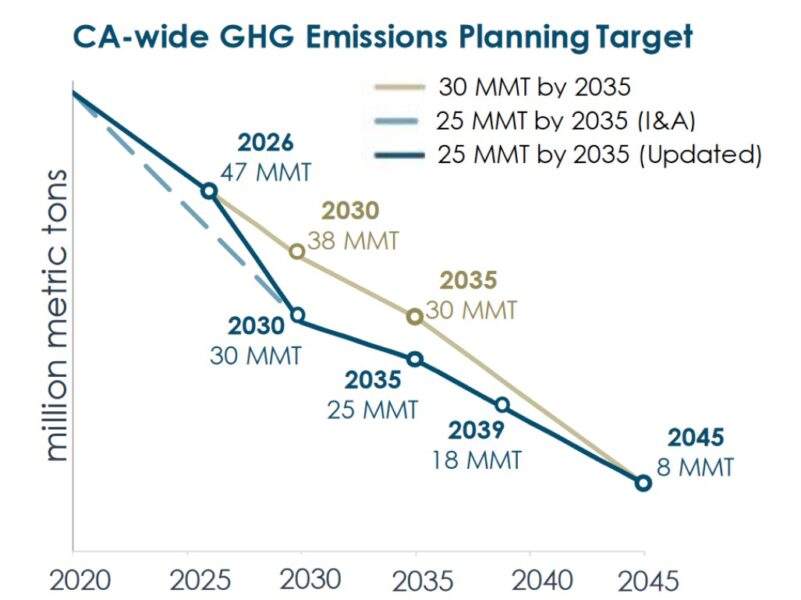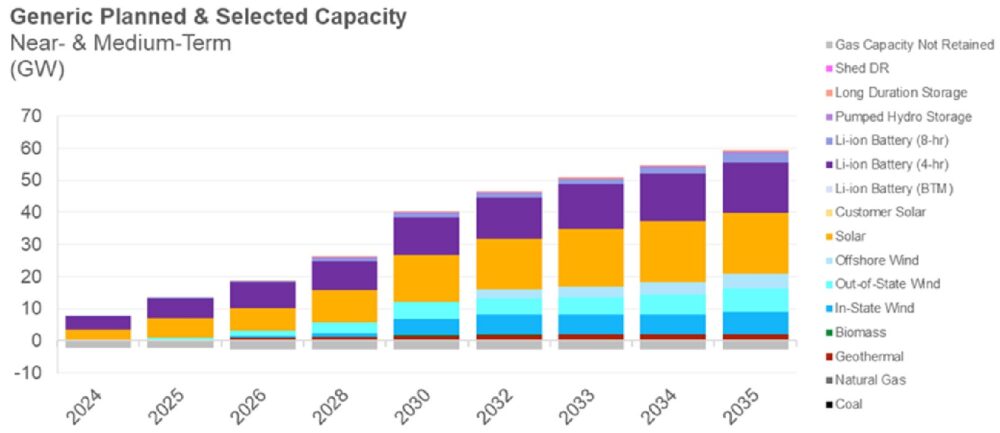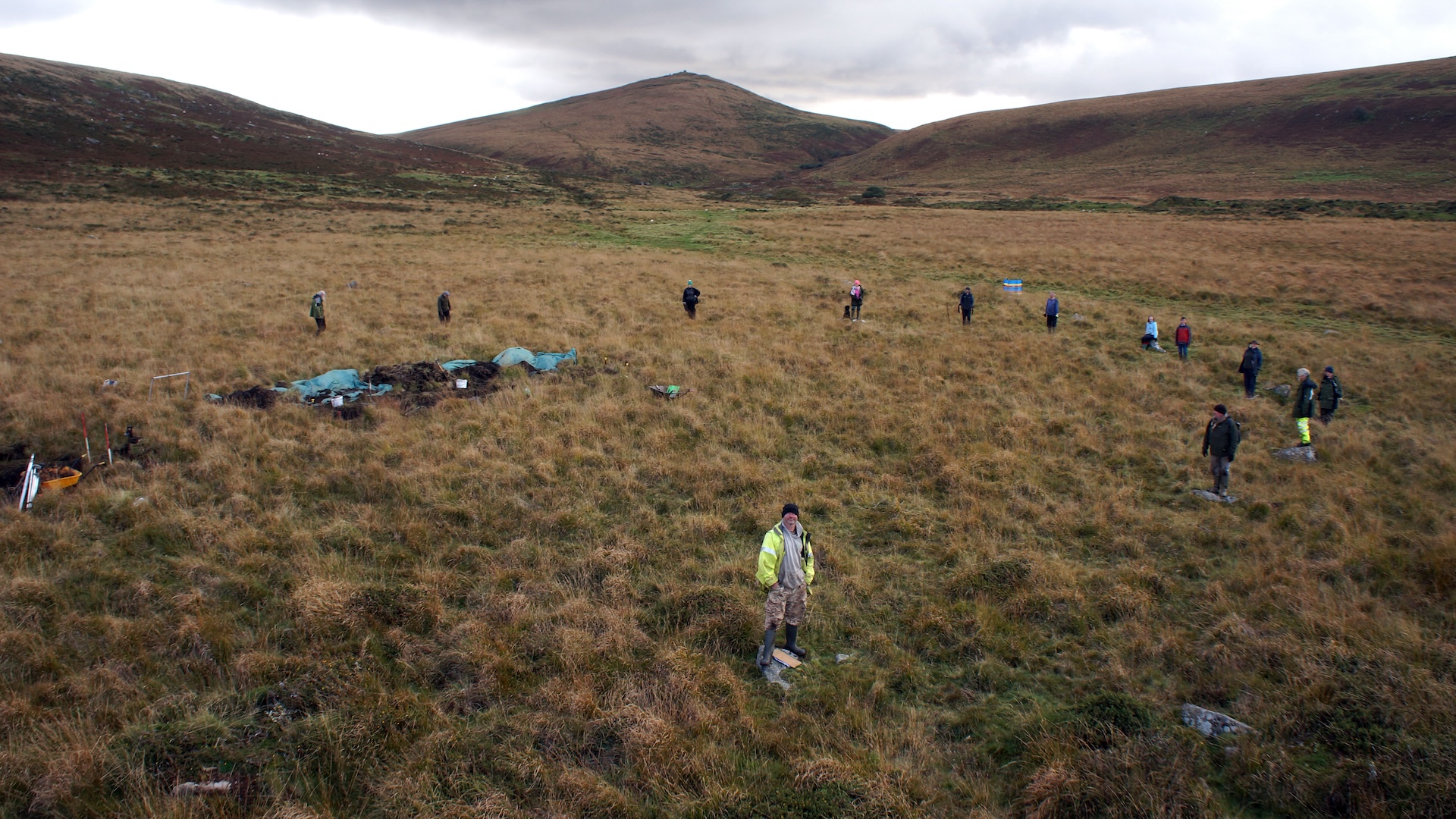Today, California took another important step in planning for the transition to clean energy, a step that’s been a long time coming.
To reach the state’s goals of 100% clean electricity and economy-wide carbon neutrality by 2045, the California Public Utilities Commission (CPUC) has been tasked with planning the clean electricity transition via its Integrated Resource Planning (IRP) process. The CPUC has a significant amount of discretion over the process; for example, the CPUC can choose to what extent and by when electricity providers must reduce their emissions.
Which brings me to the biggest news of the day: at long last, the CPUC has set an even more ambitious emissions reduction target.
This is significant because the CPUC is finally being more responsive to the urgent need to reduce global warming emissions, charting a faster course to 100% clean electricity. However, the CPUC is like a giant ship; once it gets going in a certain direction, it takes a lot of time and effort to change course. Today’s decision in the IRP process represents a milestone in a long, sweeping turn. But the turn is not yet over.
There are two positive steps that the CPUC took in this decision, but there are also two areas where additional work is badly needed and long overdue.
Positive step #1: CPUC sets a lower global warming emissions target
Today, the CPUC chose a more ambitious emissions target than it has ever selected before. California’s overall plan to decarbonize the entire economy doesn’t include an exact emissions target that the electricity sector must achieve; instead, the plan has a range. That means that it’s up to the CPUC to decide how quickly to reduce emissions from the grid.
The CPUC got off to a disappointing start roughly four years ago when it selected a weak emissions reduction target and planned to reduce electricity sector emissions down to 46 million metric tons (MMT) by 2030. (For reference, 2021 electricity sector emissions in California were roughly 60 MMT.) Over time, the CPUC has gradually ratcheted down the 2030 target, reducing it to 38 MMT two years ago, and reducing it once more to 30 MMT with today’s decision.
It took too long, but the CPUC has finally arrived at the 30 MMT emissions target for which UCS actively advocated over the past few years, along with other groups. There were multiple factors that led to this decision, but encouragingly, many electricity providers are already planning to reduce their emissions in line with the lower target, and the costs of meeting the lower target with additional clean resources were relatively small (due in part to federal Inflation Reduction Act incentives). And I have to say, it brought a smile to my face when I learned that not a single organization involved in the IRP process objected to the lower target. Again, it took too long, but it’s a promising sign that everyone is now on board!
 The CPUC is now planning to reduce electricity sector emissions down to 30 million metric tons by 2030 and 25 million metric tons by 2035 (following the dark blue line). The eventual goal of the IRP process is to reduce emissions down to 8 million metric tons by 2045. Source: CPUC.
The CPUC is now planning to reduce electricity sector emissions down to 30 million metric tons by 2030 and 25 million metric tons by 2035 (following the dark blue line). The eventual goal of the IRP process is to reduce emissions down to 8 million metric tons by 2045. Source: CPUC.Positive step #2: CAISO will study gas plant retirements
Another encouraging aspect of this decision is that the CPUC has asked the California Independent System Operator (CAISO, the grid operator in most of California) to study a sensitivity scenario that includes a little over 9 gigawatts (GW) of gas power plant retirements by 2035 and more than 15 GW of retirements by 2039. With approximately 40 GW of gas capacity currently in California, 15 GW is a huge chunk of the overall fleet.
As part of the IRP process, the CPUC regularly passes along scenarios for the CAISO to study in its transmission planning process. The sensitivity scenarios aren’t usually used as the basis for transmission investment decisions, but sensitivities can provide invaluable information for future planning processes. In this case, the gas retirements sensitivity will enable the CAISO to get a much better handle on the number and costs of transmission upgrades that would be required to enable high levels of gas plant retirements. This information can be used in future planning processes to plan for retirements in much more detail.
This development has also been a long time in the making. Starting with our Turning Down the Gas in California analysis in 2018, UCS has been pushing the CPUC to do more thoughtful, proactive planning for gas plant retirements. To be fair, the CPUC has made some progress on this over the years, but this sensitivity study is the biggest step so far.
Next step #1: Establishing procurement requirements
One of the critical areas of work that needs much more attention from the CPUC is establishing procurement requirements to ensure that California electricity providers meet their IRP goals. Setting goals and planning for the clean energy transition is important, but what really matters is following through on those plans.
Year after year, I’ve watched with increasing concern as the data comes in on the previous year’s global warming emissions. Much to my dismay, emissions from California’s electricity sector haven’t really budged since 2017. The CPUC just set an even more ambitious goal for 2030 emissions reductions, and there are now only six years left to deliver.
Until now, the CPUC has only implemented ad hoc procurement requirements in the IRP process, nearly all with the express goal of shoring up grid reliability. UCS has long advocated for a more systematic approach to procurement to ensure that California achieves all the goals of the IRP process, including grid reliability and emissions reductions.
The good news is that the CPUC has already started to think through how to structure IRP procurement requirements. The bad news is that, after asking for stakeholder feedback on the various options under consideration, it’s been absolute crickets from the CPUC for over a year now. With so much work to do between now and 2030, it’s essential for the CPUC to establish robust procurement requirements ASAP. Otherwise, California risks falling short on its climate goals.
 The CPUC’s Integrated Resource Planning (IRP) plan calls for 40 gigawatts of new resource buildout by 2030. With only six years to go, the CPUC must establish IRP procurement requirements to ensure California electricity providers follow through. Source: CPUC.
The CPUC’s Integrated Resource Planning (IRP) plan calls for 40 gigawatts of new resource buildout by 2030. With only six years to go, the CPUC must establish IRP procurement requirements to ensure California electricity providers follow through. Source: CPUC.Next step #2: Locational planning for gas plant retirements
The CPUC also needs to get much more sophisticated in its planning for gas plant retirements on a more localized level. While there were plenty of gas plant retirements in the first half of the 2010s, there haven’t been many in recent years due primarily to reliability concerns. However, the IRP modeling shows that, as California builds more and more clean resources, roughly 2.7 GW of gas capacity will no longer be needed as early as 2026.
The CPUC could just let gas plants shut down willy-nilly, leaving market forces and grid reliability requirements as the sole factors determining which plants shut down. Alternatively, the CPUC could prioritize gas plant retirements in California’s disadvantaged communities by proactively planning to bring replacement resources online, which would allow particular plants to shut down. Information from the sensitivity study I mentioned earlier (with 15 GW of gas retirements) could also be instrumental in identifying transmission solutions that enable gas plant retirements in particular areas. All in all, this type of locational planning is badly needed and long overdue.
UCS continues to press for locational planning for gas plant retirements to help ensure the transition to clean energy is equitable and just. And I especially appreciate the tireless advocacy of partner organizations that have led the charge on this issue. (I’m looking at you, California Environmental Justice Alliance and Sierra Club. Thank you!)
IRP guides the transition to clean electricity
California’s IRP process has many goals for the state’s electricity grid: reducing global warming emissions, ensuring grid reliability, keeping down the costs of electricity, minimizing local air pollutants with early priority on disadvantaged communities, and the list goes on. This process is where it all comes together, where California’s electricity providers look ahead 10 to 15 years into the future and craft a plan to meet all these objectives.
Critically, this is the venue where the CPUC ensures that electricity providers are planning to build enough solar, wind, energy storage, and other clean resources to meet California’s emissions reduction targets. With so much responsibility, the CPUC’s decisions can have significant consequences for the future of California’s grid.
The CPUC has taken positive steps with its decision today, and the giant ship that is the CPUC is indeed slowly turning in the right direction. But the long, sweeping turn isn’t over yet, as the CPUC must now prioritize critical next steps. The success of an equitable and just clean energy transition in California depends on it.

 9 months ago
40
9 months ago
40


